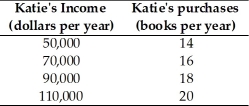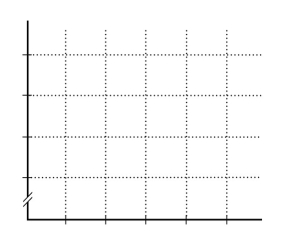
-The table above shows how the number of books Katie buys each year depends on her income
A)What kind of relationship exists between Katie's income and the number of books she purchases?

B)Plot the relationship between Katie's income and the number of books she purchases in the above figure.Measure income along the vertical axis and the number of books along the horizontal axis.Be sure to label the axes.
C)What is the slope of the relationship between $50,000 and $70,000 of income?
D)What is the slope of the relationship between $90,000 and $110,000 of income?
E)Comment on the similarity or dissimilarity of your answers to parts (c)and (d).
Definitions:
ABC Analysis
An inventory categorization technique that divides items into three categories, A, B, and C, based on their value to the company, to optimize inventory management.
Inventory Levels
The quantity of stock on hand at any given time, which companies manage to meet customer demand without incurring unnecessary costs or losses.
Carrying Cost
The total cost of holding inventory, including warehousing, spoilage, depreciation, and opportunity costs.
Economic Order Quantity
A calculation to determine the most cost-effective quantity of inventory to order, balancing ordering costs with holding costs.
Q9: A straight line falls when moving rightward
Q21: If there is a national debt,we can
Q32: What is the difference between "capital" and
Q100: The figure above shows a production possibilities
Q107: Identify the four factors of production,and tell
Q150: A point on the production possibilities frontier
Q158: On a graph showing the relationship between
Q158: If there is increasing opportunity cost,then when
Q172: In the factor market,firms _ and households
Q263: The table above shows how the number